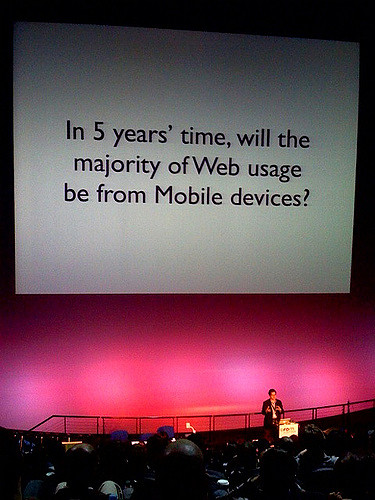
What follows are the remarks or thoughts I noted down…
Consumers
- Mobile phone users are not consumers, but creators. Phone calls, text messages are made up of a create and consume pair. I’ve heard this a great deal lately, especially in the context of the iPhone. There’s clearly some truth in it, but I wonder for how long: if my phone has a music player in it, that’s more consumption that creation. If I’m browsing the web, that’s consumption. If I’m updating a social networking site from my phone, or uploading a photo to Flickr, sure, that creating, but it’s not unique to the phone. Email and IM can also be a create and consume pair, and that’s something you can do on the desktop or the handset. I’m not sure the whole active v. passive consumers meme is terribly useful.
- Mobile’s combination of location plus attention is a unique advertising opportunity.
Content creation
- “Vodafone UK and Novarra are breaking the mobile web”. (See TechCrunch)
- If you’re anti One Web, Luca Passani’s alternative to the W3C’s Mobile Web Best Practices will be something you’ll want to read: Global Authoring Practices for the Mobile Web
- One Web is about thematic consistency: “Ensure that content provided by accessing a URI yields a thematically coherent experience when accessed from different devices.”
- WURFL has 3,000 developers, and WALL (Wireless abstraction library - a markup system to help automatically output the right kind of markup for different devices) is going into a new version: WNG. Slides are available for that announcement.
- .Mobi exists to “help the mobile web grow”. The Device Description Repository (DDR) API is due in Dec 2007/Jan 2008, but isn’t based on WURFL. The reason is that .mobi want to “add trust” and “add industry” to the API, protecting companies against possible royalty payments, and to provide confidence via a brand.
- Google mobile search is currently terrible.
Mobile AJAX
- Daniel Appelquist: Mobile Ajax will replace a class of application currently written in Java, will reduce time to market, open up the space to more developers, and result in more apps.
- Challenges for mobile Ajax: access to device hardware, consequences of privacy control, need for developer guidelines.
- Charles McCathieNevile: ECMAScript 4 is a “proper programming language”, which might help reduce the amount of battery power that Javascript consumes.
Android
There was lots of interest in Android.
- It’s a full-stack mobile solution, and open source. Based on Linux 2.6, plus a hardware spec, apps, and Java.
- Android exists to promote openness, build a loyal developer base, grow Google experience, and make handsets cheaper (software is 10% of the handset BOM).
- Each application is a separate Linux process, and all apps are equal to the operating system. It will include two-way synchronization (it’ll be interesting to see how they’ve solved that problem).
- Google are not worried about writing specs, and just wanted to write it and get the code out.
- The architecture does allow for support of MIDP applications alongside Android applications. The Java implementation is Dalvik, plus a collection of useful Java packages.
- The claim is that the richer APIs provided give more control compared to MIDP.
- The system will be completely open source as soon as the first handset shipped. This isn’t expected until late 2008.
Some of presentations have started to appear on SlideShare.